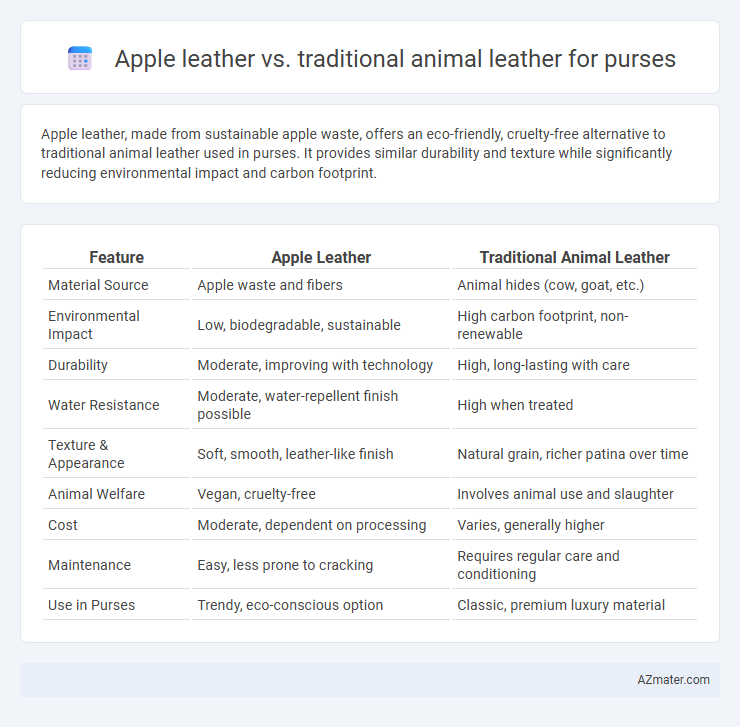Apple leather, made from sustainable apple waste, offers an eco-friendly, cruelty-free alternative to traditional animal leather used in purses. It provides similar durability and texture while significantly reducing environmental impact and carbon footprint.
Table of Comparison
| Feature | Apple Leather | Traditional Animal Leather |
|---|---|---|
| Material Source | Apple waste and fibers | Animal hides (cow, goat, etc.) |
| Environmental Impact | Low, biodegradable, sustainable | High carbon footprint, non-renewable |
| Durability | Moderate, improving with technology | High, long-lasting with care |
| Water Resistance | Moderate, water-repellent finish possible | High when treated |
| Texture & Appearance | Soft, smooth, leather-like finish | Natural grain, richer patina over time |
| Animal Welfare | Vegan, cruelty-free | Involves animal use and slaughter |
| Cost | Moderate, dependent on processing | Varies, generally higher |
| Maintenance | Easy, less prone to cracking | Requires regular care and conditioning |
| Use in Purses | Trendy, eco-conscious option | Classic, premium luxury material |
Introduction: Apple Leather vs Traditional Animal Leather
Apple leather offers an innovative, sustainable alternative to traditional animal leather, crafted from apple peel waste with a lower environmental footprint. This plant-based material provides durability and a soft texture, making it suitable for stylish purses while reducing reliance on animal farming. Traditional animal leather, typically derived from cowhide, is known for its robustness and natural patina but involves intensive water use, chemical treatments, and ethical concerns related to animal welfare.
Material Composition and Sourcing
Apple leather is crafted from the fibrous remains of apple peels and cores, offering a sustainable alternative to traditional animal leather derived from bovine hides. The sourcing of apple leather utilizes agricultural waste from apple processing industries, reducing environmental impact and promoting circular economy practices. In contrast, traditional animal leather involves livestock farming, which requires extensive land, water, and chemical use, contributing to higher carbon emissions and resource depletion.
Environmental Impact and Sustainability
Apple leather, crafted from apple waste, offers a biodegradable and renewable alternative to traditional animal leather, significantly reducing reliance on livestock farming, which is a major contributor to greenhouse gas emissions and deforestation. This innovative material requires less water and energy during production, minimizing its carbon footprint and helping to prevent chemical pollution associated with tanning processes used in animal leather manufacturing. Choosing apple leather purses supports sustainable fashion by promoting circular economy principles and reducing the environmental impact tied to leather goods.
Durability and Longevity Comparison
Apple leather, made from apple peel waste, offers increased resistance to cracking and water damage compared to traditional animal leather, making it a durable choice for purses. Unlike conventional leather, apple leather maintains its structural integrity without heavy tanning chemicals, extending the lifespan of the product under regular use. This sustainable material resists fading and wear, ensuring longevity that rivals or surpasses many types of traditional animal leather.
Aesthetic Qualities and Texture
Apple leather offers a smooth, uniform texture with a matte finish that mimics the look of traditional animal leather while providing a modern and sustainable aesthetic. Its surface often exhibits a more consistent grain pattern and a softer feel compared to the natural variations and occasional imperfections found in genuine animal leather. The vibrant yet muted tones achievable in apple leather create a stylish and contemporary accessory ideal for purses, appealing to eco-conscious consumers seeking both beauty and comfort.
Weight and Comfort for Everyday Use
Apple leather purses offer a lightweight alternative to traditional animal leather, reducing strain during all-day wear and enhancing portability. The breathable texture of apple leather improves comfort by preventing moisture buildup, making it ideal for everyday use. Unlike conventional leather, apple leather maintains softness and flexibility without the heavy, rigid feel often associated with animal hide.
Care, Maintenance, and Aging
Apple leather offers easier care and maintenance compared to traditional animal leather, requiring only mild cleaning with a damp cloth and avoiding harsh chemicals. It resists water and stains more effectively, reducing the need for frequent conditioning or protective treatments commonly necessary for animal leather. Over time, apple leather maintains its appearance without developing the natural patina or wrinkles typical of traditional leather, making it a versatile and low-maintenance option for purses.
Allergies and Skin Sensitivity
Apple leather offers a hypoallergenic alternative to traditional animal leather, reducing the risk of allergic reactions and irritation for sensitive skin. Made from natural apple waste and plant-based materials, it lacks the animal proteins and heavy tanning chemicals often responsible for skin sensitivities. This innovative material provides a breathable, cruelty-free option that is gentler on skin compared to conventional leather purses.
Cost Analysis: Upfront and Long-term Value
Apple leather purses generally have a lower upfront cost compared to premium traditional animal leather purses, making them more affordable for budget-conscious consumers. Over time, the durability of traditional animal leather often results in a longer lifespan and improved aging characteristics, potentially offering better long-term value despite higher maintenance expenses. Apple leather provides a sustainable alternative with reduced environmental impact but may require more frequent replacement, affecting total cost of ownership.
Ethical Considerations and Consumer Choice
Apple leather, crafted from renewable apple waste, offers an eco-friendly and cruelty-free alternative to traditional animal leather, reducing the environmental impact and ethical concerns associated with livestock farming and animal cruelty. Consumers increasingly favor apple leather purses for their alignment with sustainable fashion and vegan lifestyles, driven by heightened awareness of animal welfare and environmental preservation. This shift in consumer choice reflects a growing demand for products that combine ethical sourcing with durability and aesthetic appeal, challenging the dominance of conventional animal leather in the luxury accessory market.

Infographic: Apple leather vs Traditional animal leather for Purse
 azmater.com
azmater.com